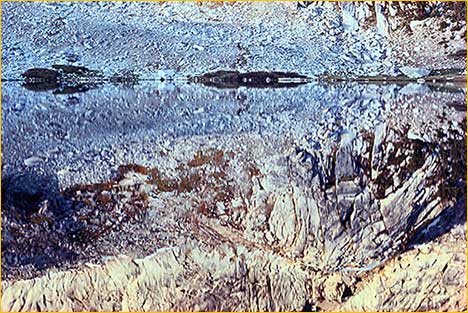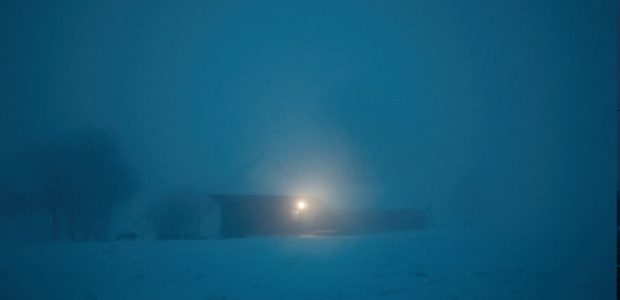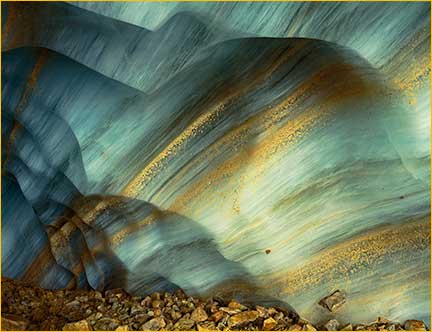

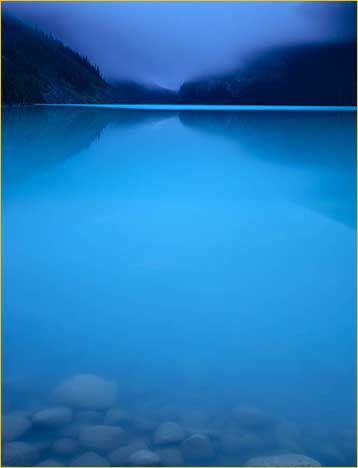
Dawn, Lake Louise, Banff National Park, Canada 1995
If you ask a photographer what kind of images he or she makes, the answer most commonly refers to a list of divergent subjects.
Over the years, I have seen evidence of the camera’s seductive power in student work. Most of us have diverse visual interests and are naturally pulled towards many subjects. This wouldn’t be anything to worry about except that a broad focus often leads to a less than optimal portfolio without focus. Certainly the world is full of wonders to photograph, but how many of us have the time to take every branch in the road? The hectic pace of our lives, and the expediency of clicking the shutter, conspires to distract us!
In my experience of teaching photography for the past twenty-five years and reviewing portfolios, I have not often seen work presented in a tightly edited and conceptual concise manner. In recent years, through the process of teaching an online course (see Final Notes below), I have found a great way to improve your photography and give it more focus – by determining the major themes within your photo library, and developing refined and concise portfolios of those themes that inspire you the most.
My teaching experience tells me that many photographers, at all levels, can benefit from this more focused approach to creating, organizing and marketing their imagery. The first phase in this process is to determine what themes already exist in your photographs. After discovering which of those that are the most promising, the next step is to edit the images into portfolios that showcase your best work.

Striated wall of an ice cave, Jasper National Park, Alberta, Canada

Agave colorata, Huntington Botanical Gardens, San Marino, California, 1991
One theme I have pursed since I started making images 35 years ago is patterns in Nature. In fact, my photographs were used to illustrate the subject in a book entitled By Nature’s Design.
Although I photographed many new images for the book, my files contained many previously made images that reflect my fascination with the subject. It is a theme I continue to pursue today: By Nature’s Design Portfolio.
It is important to consider what subjects REALLY matter to you, themes about which you are most passionate. The subject can be broad, such as forests or as narrow as aspen, but the important thing is to focus on a theme, and to photograph with the idea of creating a portfolio. In my definition, a portfolio can take many forms and potential uses- a portfolio box of fine prints, a book, a digital slide show, or perhaps a gallery exhibit.
When working on a student’s critique, I often find a few good images mixed in with many lesser ones. The overall impression is less than strong, the quality level lowered by the weaker ones. When I pull out the weaker images, then set aside the best ones to define a stronger portfolio, the photographer instantly becomes a better photographer! Even when setting aside only two or three “best” images, good editing elevates the photographer’s sense of his or her achievement and ability. It can be a positive experience. If you don’t think you are a tough enough editor (yet!), then a workshop that includes critique sessions with an experienced pro will surely help. It is difficult to be brutal with your own work. Maybe if you imagine a workshop instructor looking over your shoulder as you edit, you will be more selective!
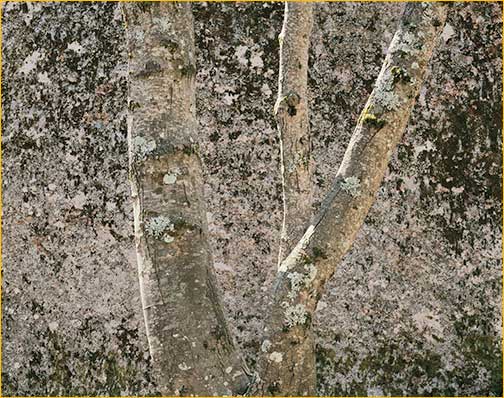
Alder and granite boulder, Yosemite Valley, Yosemite National Park, California 1984
Your project could last just a few months, or last a lifetime. The most enduring theme for me is the one I developed over two decades, and published in book form – Landscapes of the Spirit. Although the book has been out of print for many years, I have recently released an e-book version – Landscapes of the Spirit – Digital Edition. I continue to add work to the theme: Landscapes of the Spirit – Volume Two.
There are two main requirements for building a strong portfolio. First, there must be a coherent theme. For example, you could pick a theme of landscapes that relate to water. Possible images could include waterfalls, rivers, lakes, or the ocean.
The second criterion is that there should be no one image that is of lesser quality than another. Remember that, in any situation where you show your work, great images are diluted by the average images that you might use to “fill out” your presentation, and the overall impression of your photography is reduced. I wish that more photographic instruction emphasized the importance of editing.
The next step is to go through your files to find your very best “water landscapes,” or whichever theme you’ve chosen. If you adhere to my second premise, you will find the editing difficult! Being self-critical is critical! Don’t be surprised if you only find a few images that are of equally high quality. The ultimate editor is you, the artist, but you may find it valuable to have your work evaluated by other, more experienced photographers, such as a workshop instructor. This “second opinion” approach will either confirm, or force you to reconsider, the level of your imagery.
You should now have the foundation for your portfolio, be it two or twenty images, and a baseline from which to measure your progress. When you continue to photograph for the portfolio, your planning, exploring and image making is concentrated on the theme. As you refine and add to your theme, consider the balance and coherence in terms of subject, lighting, compositional style, scale, and overall creativity.
New images are compared to your standards of excellence, and can be added to the portfolio if they measure up. Over time, some new images might replace the original images as the overall quality of the portfolio is elevated. The images that endure, that still excite you, remain in the portfolio. By evaluating this collection of premier images often, you can see, and are rewarded by, your progress.
How many photographs should be included in a portfolio? The size of a portfolio depends on the form of presentation and the audience. If you are creating a book, either to submit to a publisher or to self-print or publish, the need for at least 40-50 excellent images makes sense to me. If you are creating a box of fine art prints, either for yourself or to present to a gallery, I recommend a smaller number, say 20-30 photographs.
It is important that you do your research by asking how many photographs the publisher, gallery director or editor wants to see. By checking for submissions guidelines, you will also learn what forms of presentation are acceptable. For a great source of information on marketing your art, see Mary Virginia Swanson’sThe Business Of Photography: Principles And Practices (http://www.mvswanson.com/businessbook/index.php).
One photograph of mine, shown here, has assumed a position among my select tree photographs. As is often the case for me, the process of creating this image began with discovery and a sense of wonder. The roots of these trees thoroughly amazed me with their grace and determination! My judgment of the image rests on: the overall technical quality; that I feel the image is as good as my best tree photographs; and that the image reconnects me with the sublime experience of being there.

Trees growing on moss-covered boulders, Baxter State Park, Maine, 1995
To compose this image, I had to maneuver my tripod onto a nearly vertical, muddy slope and use a 90mm wide-angle lens on my 4×5. This slope limited my options and forced me to compose tightly as I was using the widest-angle lens I have. The viewer’s attention is centered on the two roots coming down the rock. The entire boulder is not shown but its large size is implied. A sense of the surrounding forest is conveyed by small sections of trunks visible across the top of the frame. The previous night’s rainstorm had knocked down an abundance of leaves, which added an extra dimension to the wonder of the scene. The rainfall and the softness of the lighting conditions allowed the film to record rich, saturated colors.
Once you have explored a theme in depth, and hopefully you have seen your own vision of the subject grow and coalesce, you will probably find other themes in your work to cultivate into new portfolios. I am constantly thinking about themes in my own body of work to develop! Creative thinking along these lines may lead you to themes, evolving from your own personal passions that are yet unexplored by other photographers. The potential for rewards in terms of personal satisfaction, in the refinement of your presentation, and for marketing your work are increased. The first level of creativity comes with the image-making, but the next phase comes with the editing and organization of images in ways that reflect the photographer’s unique style and perspective.
Find your passion, develop depth, edit tightly! Simply put: focus!
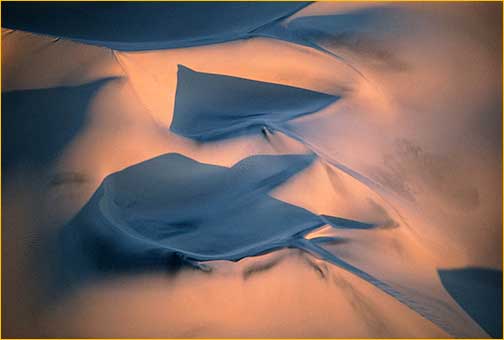
Dune Patterns, Aerial, Death Valley National Monument, California 1989
It is the photographer’s task to explore, photograph and share with others the multitude of interesting aspects in our world and our lives. We expose to others what we see, that which they might otherwise miss. What a joyful job!
______________________________________________________________
After Notes
I have two websites that show portfolios of my work.
Please see http://www.williamneillphotography.comandhttp://www.williamneill.com/ to view them. These groupings may help you visualize the idea of a portfolio. Although opinions on individual images will vary widely, try to look for balance in the subject matter and consistent quality when you view thematic books or exhibits by photographers you like. Note: my online portfolios are relatively large, selected for a broad range of web viewers and not tightly edited for specific publishers or galleries.
To summarize, here are some suggestions and conclusions:
â�¢ Pick a theme about which you feel passionate, and that shows off your personal vision. When you begin looking through your images, consider both the technical and emotional qualities. Try to judge each photograph½s merits relative to the other selections within the theme so that the collective group is of equal, or near equal, quality.
� Work at tightening up a theme you select to create a balanced group and by refining the visual themes. For example, if you select to make a portfolio entitled Water, balancing your edit might include photographs showing the many ways we see water in nature. Your photographs could include ones of ice, mist, waterfalls, surf, reflections, blurred water from long exposures, water frozen by fast shutter speeds, etc. Too many of one type of water image might give an unbalanced effect. If you find gaps in your interpretation of your theme, assign yourself to make new images to fill the gaps.
â�¢ Titling your portfolio may well help you define what the images are about. Like giving a title to a book, the name you give to your theme will be critical to how viewers think about the images within. It is also an opportunity to be more poetic than descriptive. If ½Water>½ as a title sounds too simple or boring, try something more creative like, ½The Art of Water,” or “Water: Cycle of Life.”
Reflections, Young Lakes, Yosemite National Park, California 1977
Here is a water reflection image I made with 35mm in 1977, the first year I moved to Yosemite. It exemplifies several stylistic approaches to landscape photography that I look for: an isolated section of a scene, abstraction, magic light and pattern
I teach an 8-week online course entitled Portfolio Development for BetterPhoto.com. It is designed to take the student through an intensive process of conceiving themes, editing new and previous work, and then developing a strong thematic portfolio ready for presentation. I have been teaching it for three years now, and I see most students progressing remarkably during the course.
For more information about Landscapes of the Spirit – Digital Edition, please visit my web site. I also invite you to visit my Light on the Landscape Photoblog where I share my thoughts about photography and post my latest images.
______________________________________________________________
William Neill, a resident of the Yosemite National Park area since 1977, is a landscape photographer concerned with conveying the deep, spiritual beauty he sees and feels in Nature. Neill’s award-winning photography has been widely published in books, magazines, calendars, posters, and his limited edition prints have been collected and exhibited in museums and galleries nationally, including the Museum of Fine Art Boston, Santa Barbara Museum of Art, The Vernon Collection, and The Polaroid Collection. Neill received a BA degree in Environmental Conservation at the University of Colorado. In 1995, Neill received the Sierra Club’s Ansel Adams Award for conservation photography. Neill is a member of Canon USA’s elite Explorers Of Light and Print Masters.

Lorem ipsum dolor sit amet, consectetur adipiscing elit, sed do eiusmod tempor incididunt ut labore et dolore magna aliqua. Ut enim ad minim veniam, quis nostrud exercitation ullamco laboris nisi ut aliquip ex ea commodo consequat. Duis aute irure dolor in reprehenderit in voluptate velit esse cillum dolore eu fugiat nulla pariatur. Excepteur sint occaecat cupidatat non proident, sunt in culpa qui officia deserunt mollit anim id est laborum.
You May Also Enjoy...
The Still Life of Cinema: Michael LeBlanc
FacebookTweet I first met Michael LeBlanc 18 years ago, when I was a touring musician with a label in need of a video and
